SCEN6058: Stakeholder & Community Engagement: Spring 2018 Report
VerifiedAdded on 2023/06/10
|18
|6183
|461
Report
AI Summary
This report provides an analysis of stakeholder and community engagement, focusing on the functions and importance of various stakeholder groups, the development of an effective community engagement plan, and the evaluation of appropriate communication strategies. It examines the roles of internal and external stakeholders, highlighting the significance of transparent communication, empowerment, and consistent engagement. The report also explores stakeholder mapping, influence assessment, and proactive mitigation strategies to predict stakeholder behavior. Furthermore, it evaluates stakeholder management theories and the use of social media to enhance stakeholder engagement, emphasizing the pivotal role of stakeholders in the success of a business organization. The analysis includes practical considerations for building successful stakeholder relationships and resolving conflicts, ultimately aiming to improve decision-making and competitiveness.
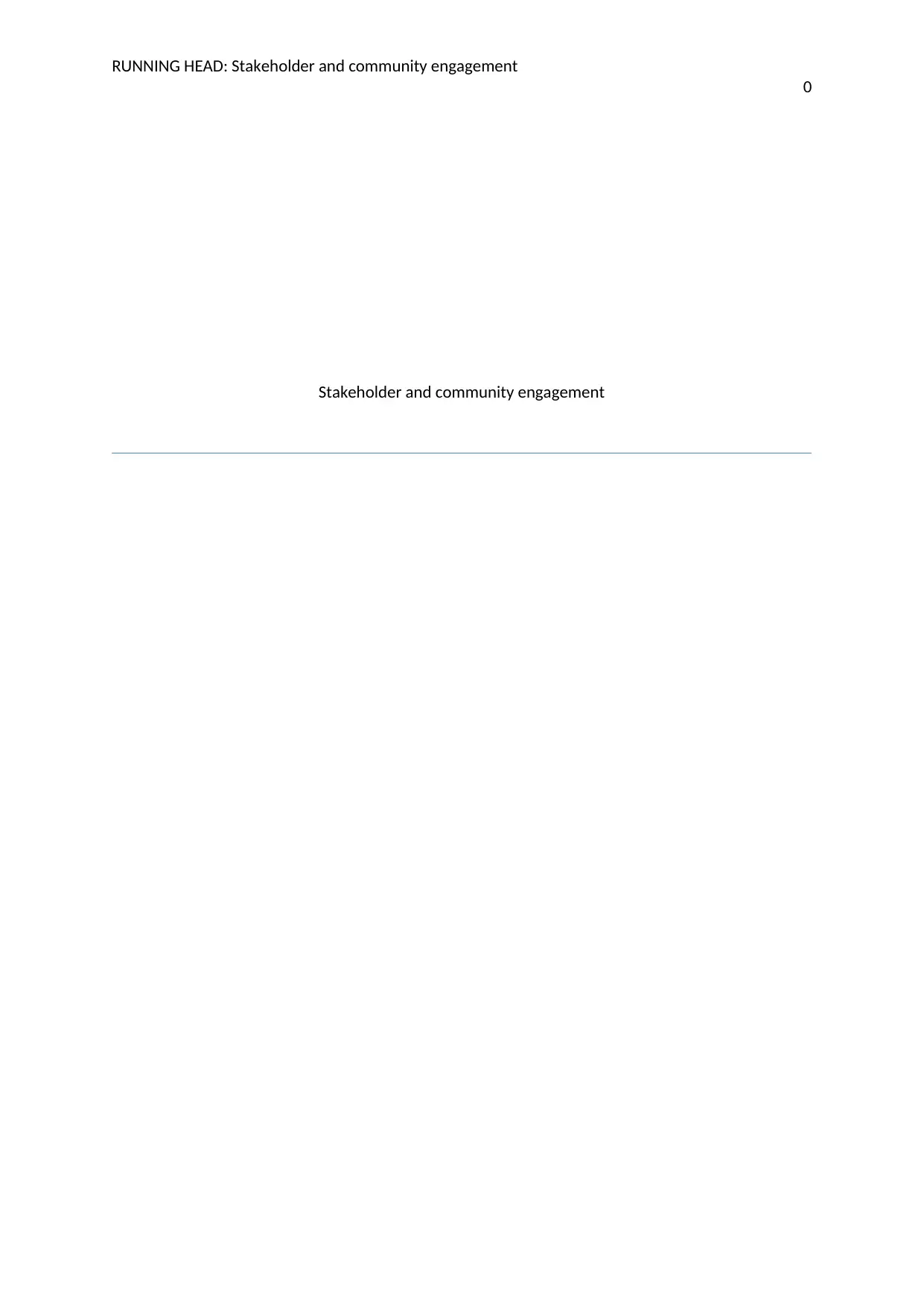
RUNNING HEAD: Stakeholder and community engagement
0
Stakeholder and community engagement
0
Stakeholder and community engagement
Paraphrase This Document
Need a fresh take? Get an instant paraphrase of this document with our AI Paraphraser
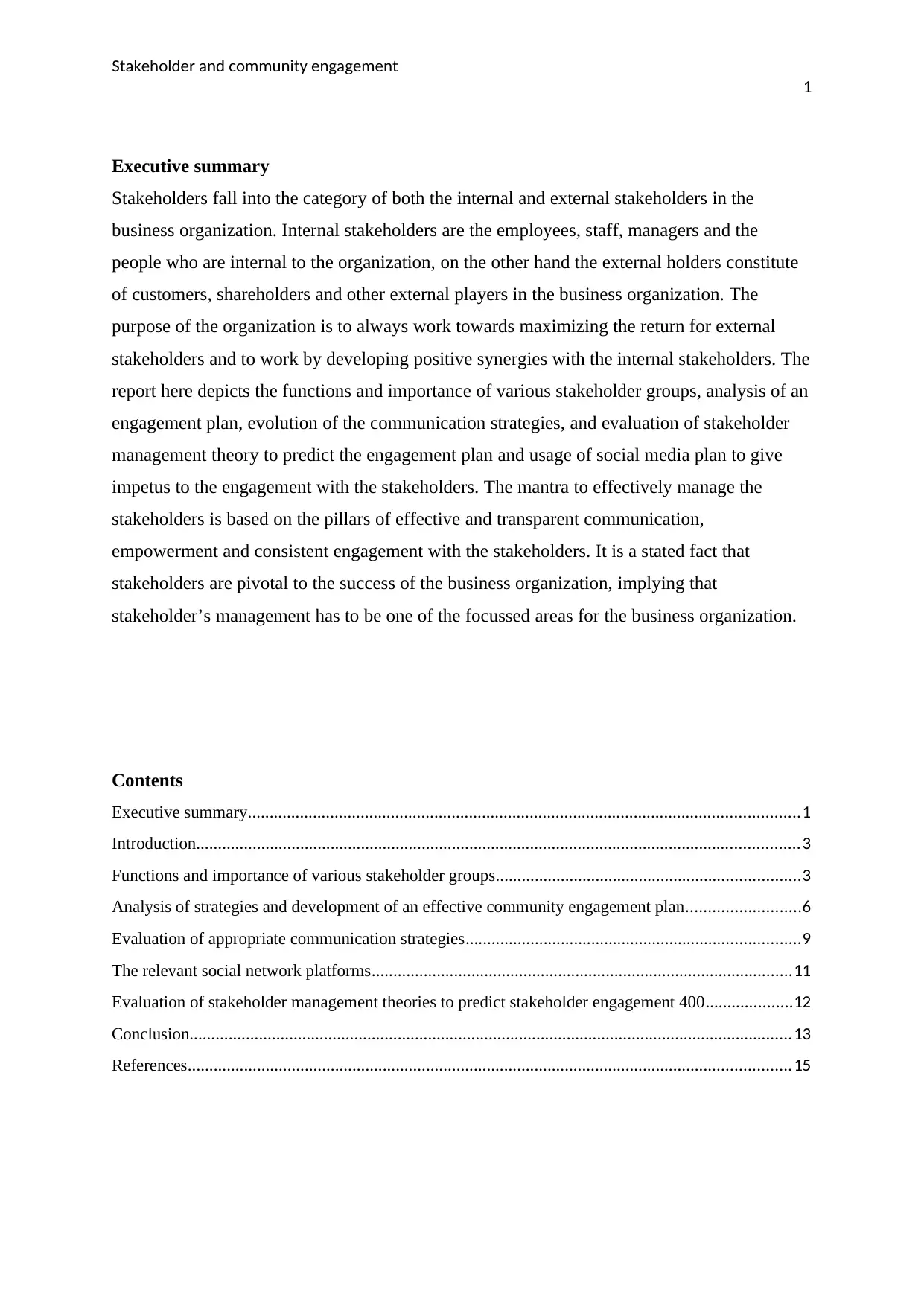
Stakeholder and community engagement
1
Executive summary
Stakeholders fall into the category of both the internal and external stakeholders in the
business organization. Internal stakeholders are the employees, staff, managers and the
people who are internal to the organization, on the other hand the external holders constitute
of customers, shareholders and other external players in the business organization. The
purpose of the organization is to always work towards maximizing the return for external
stakeholders and to work by developing positive synergies with the internal stakeholders. The
report here depicts the functions and importance of various stakeholder groups, analysis of an
engagement plan, evolution of the communication strategies, and evaluation of stakeholder
management theory to predict the engagement plan and usage of social media plan to give
impetus to the engagement with the stakeholders. The mantra to effectively manage the
stakeholders is based on the pillars of effective and transparent communication,
empowerment and consistent engagement with the stakeholders. It is a stated fact that
stakeholders are pivotal to the success of the business organization, implying that
stakeholder’s management has to be one of the focussed areas for the business organization.
Contents
Executive summary...............................................................................................................................1
Introduction...........................................................................................................................................3
Functions and importance of various stakeholder groups......................................................................3
Analysis of strategies and development of an effective community engagement plan..........................6
Evaluation of appropriate communication strategies.............................................................................9
The relevant social network platforms.................................................................................................11
Evaluation of stakeholder management theories to predict stakeholder engagement 400....................12
Conclusion...........................................................................................................................................13
References...........................................................................................................................................15
1
Executive summary
Stakeholders fall into the category of both the internal and external stakeholders in the
business organization. Internal stakeholders are the employees, staff, managers and the
people who are internal to the organization, on the other hand the external holders constitute
of customers, shareholders and other external players in the business organization. The
purpose of the organization is to always work towards maximizing the return for external
stakeholders and to work by developing positive synergies with the internal stakeholders. The
report here depicts the functions and importance of various stakeholder groups, analysis of an
engagement plan, evolution of the communication strategies, and evaluation of stakeholder
management theory to predict the engagement plan and usage of social media plan to give
impetus to the engagement with the stakeholders. The mantra to effectively manage the
stakeholders is based on the pillars of effective and transparent communication,
empowerment and consistent engagement with the stakeholders. It is a stated fact that
stakeholders are pivotal to the success of the business organization, implying that
stakeholder’s management has to be one of the focussed areas for the business organization.
Contents
Executive summary...............................................................................................................................1
Introduction...........................................................................................................................................3
Functions and importance of various stakeholder groups......................................................................3
Analysis of strategies and development of an effective community engagement plan..........................6
Evaluation of appropriate communication strategies.............................................................................9
The relevant social network platforms.................................................................................................11
Evaluation of stakeholder management theories to predict stakeholder engagement 400....................12
Conclusion...........................................................................................................................................13
References...........................................................................................................................................15
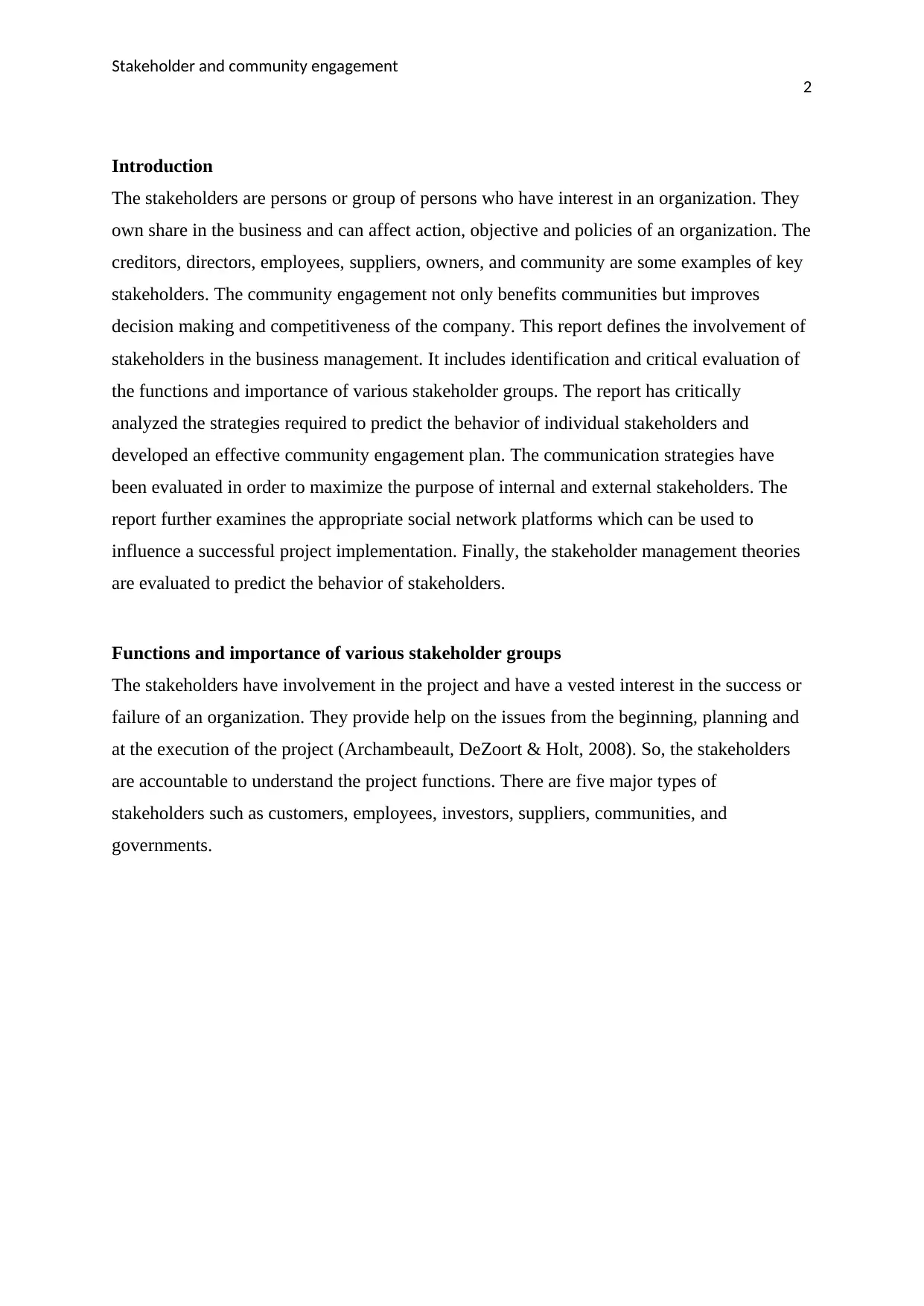
Stakeholder and community engagement
2
Introduction
The stakeholders are persons or group of persons who have interest in an organization. They
own share in the business and can affect action, objective and policies of an organization. The
creditors, directors, employees, suppliers, owners, and community are some examples of key
stakeholders. The community engagement not only benefits communities but improves
decision making and competitiveness of the company. This report defines the involvement of
stakeholders in the business management. It includes identification and critical evaluation of
the functions and importance of various stakeholder groups. The report has critically
analyzed the strategies required to predict the behavior of individual stakeholders and
developed an effective community engagement plan. The communication strategies have
been evaluated in order to maximize the purpose of internal and external stakeholders. The
report further examines the appropriate social network platforms which can be used to
influence a successful project implementation. Finally, the stakeholder management theories
are evaluated to predict the behavior of stakeholders.
Functions and importance of various stakeholder groups
The stakeholders have involvement in the project and have a vested interest in the success or
failure of an organization. They provide help on the issues from the beginning, planning and
at the execution of the project (Archambeault, DeZoort & Holt, 2008). So, the stakeholders
are accountable to understand the project functions. There are five major types of
stakeholders such as customers, employees, investors, suppliers, communities, and
governments.
2
Introduction
The stakeholders are persons or group of persons who have interest in an organization. They
own share in the business and can affect action, objective and policies of an organization. The
creditors, directors, employees, suppliers, owners, and community are some examples of key
stakeholders. The community engagement not only benefits communities but improves
decision making and competitiveness of the company. This report defines the involvement of
stakeholders in the business management. It includes identification and critical evaluation of
the functions and importance of various stakeholder groups. The report has critically
analyzed the strategies required to predict the behavior of individual stakeholders and
developed an effective community engagement plan. The communication strategies have
been evaluated in order to maximize the purpose of internal and external stakeholders. The
report further examines the appropriate social network platforms which can be used to
influence a successful project implementation. Finally, the stakeholder management theories
are evaluated to predict the behavior of stakeholders.
Functions and importance of various stakeholder groups
The stakeholders have involvement in the project and have a vested interest in the success or
failure of an organization. They provide help on the issues from the beginning, planning and
at the execution of the project (Archambeault, DeZoort & Holt, 2008). So, the stakeholders
are accountable to understand the project functions. There are five major types of
stakeholders such as customers, employees, investors, suppliers, communities, and
governments.
⊘ This is a preview!⊘
Do you want full access?
Subscribe today to unlock all pages.

Trusted by 1+ million students worldwide
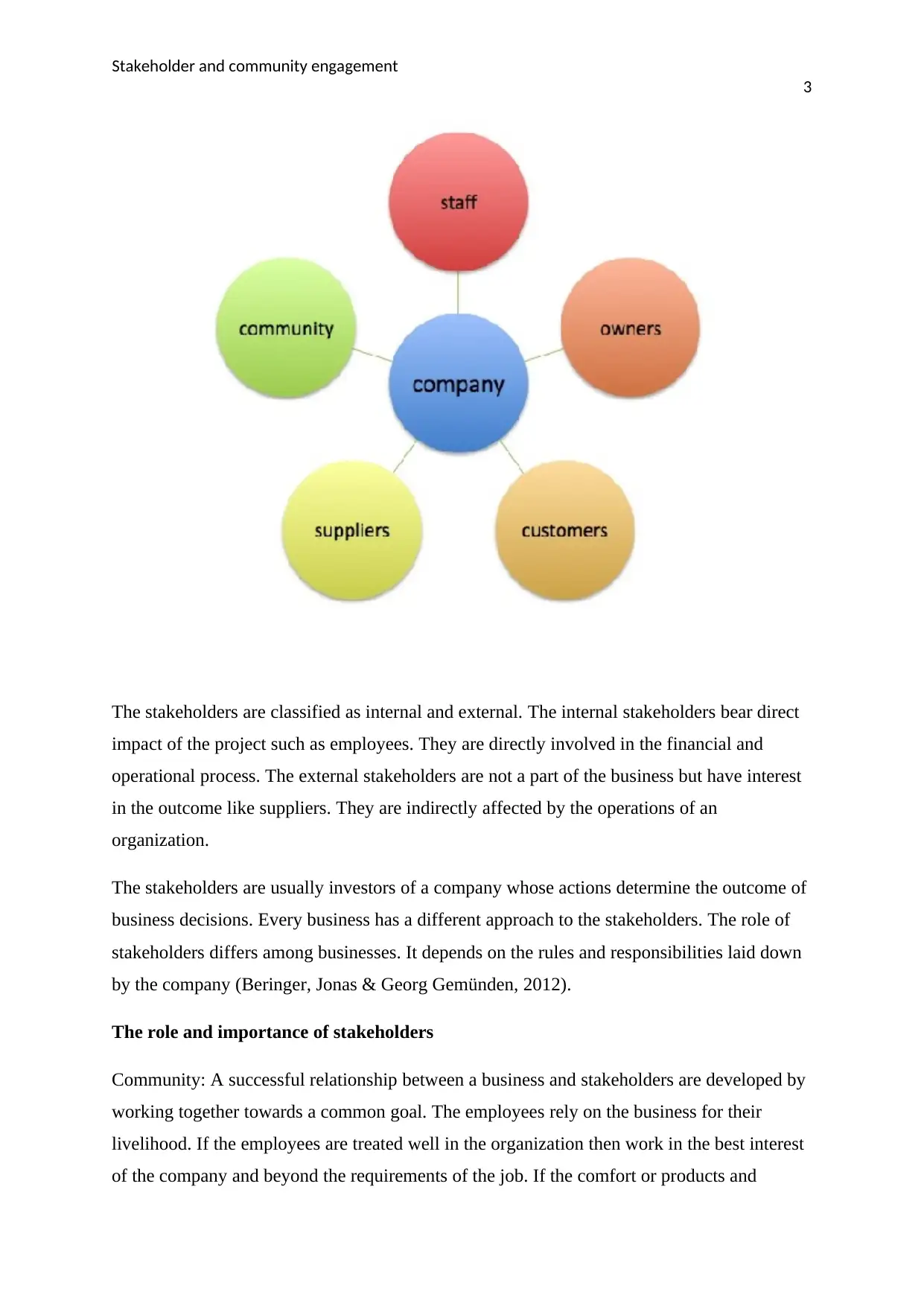
Stakeholder and community engagement
3
The stakeholders are classified as internal and external. The internal stakeholders bear direct
impact of the project such as employees. They are directly involved in the financial and
operational process. The external stakeholders are not a part of the business but have interest
in the outcome like suppliers. They are indirectly affected by the operations of an
organization.
The stakeholders are usually investors of a company whose actions determine the outcome of
business decisions. Every business has a different approach to the stakeholders. The role of
stakeholders differs among businesses. It depends on the rules and responsibilities laid down
by the company (Beringer, Jonas & Georg Gemünden, 2012).
The role and importance of stakeholders
Community: A successful relationship between a business and stakeholders are developed by
working together towards a common goal. The employees rely on the business for their
livelihood. If the employees are treated well in the organization then work in the best interest
of the company and beyond the requirements of the job. If the comfort or products and
3
The stakeholders are classified as internal and external. The internal stakeholders bear direct
impact of the project such as employees. They are directly involved in the financial and
operational process. The external stakeholders are not a part of the business but have interest
in the outcome like suppliers. They are indirectly affected by the operations of an
organization.
The stakeholders are usually investors of a company whose actions determine the outcome of
business decisions. Every business has a different approach to the stakeholders. The role of
stakeholders differs among businesses. It depends on the rules and responsibilities laid down
by the company (Beringer, Jonas & Georg Gemünden, 2012).
The role and importance of stakeholders
Community: A successful relationship between a business and stakeholders are developed by
working together towards a common goal. The employees rely on the business for their
livelihood. If the employees are treated well in the organization then work in the best interest
of the company and beyond the requirements of the job. If the comfort or products and
Paraphrase This Document
Need a fresh take? Get an instant paraphrase of this document with our AI Paraphraser
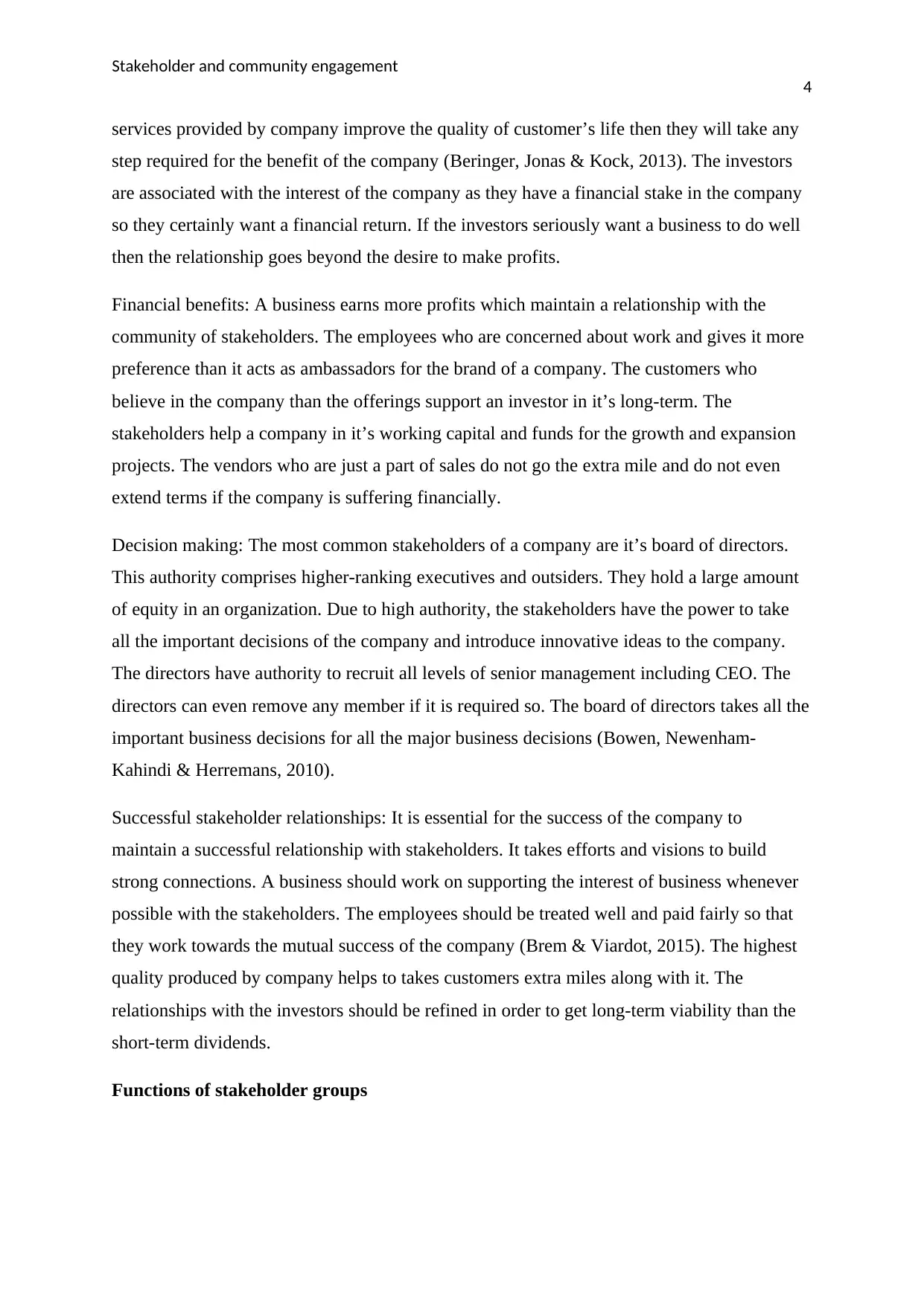
Stakeholder and community engagement
4
services provided by company improve the quality of customer’s life then they will take any
step required for the benefit of the company (Beringer, Jonas & Kock, 2013). The investors
are associated with the interest of the company as they have a financial stake in the company
so they certainly want a financial return. If the investors seriously want a business to do well
then the relationship goes beyond the desire to make profits.
Financial benefits: A business earns more profits which maintain a relationship with the
community of stakeholders. The employees who are concerned about work and gives it more
preference than it acts as ambassadors for the brand of a company. The customers who
believe in the company than the offerings support an investor in it’s long-term. The
stakeholders help a company in it’s working capital and funds for the growth and expansion
projects. The vendors who are just a part of sales do not go the extra mile and do not even
extend terms if the company is suffering financially.
Decision making: The most common stakeholders of a company are it’s board of directors.
This authority comprises higher-ranking executives and outsiders. They hold a large amount
of equity in an organization. Due to high authority, the stakeholders have the power to take
all the important decisions of the company and introduce innovative ideas to the company.
The directors have authority to recruit all levels of senior management including CEO. The
directors can even remove any member if it is required so. The board of directors takes all the
important business decisions for all the major business decisions (Bowen, Newenham-
Kahindi & Herremans, 2010).
Successful stakeholder relationships: It is essential for the success of the company to
maintain a successful relationship with stakeholders. It takes efforts and visions to build
strong connections. A business should work on supporting the interest of business whenever
possible with the stakeholders. The employees should be treated well and paid fairly so that
they work towards the mutual success of the company (Brem & Viardot, 2015). The highest
quality produced by company helps to takes customers extra miles along with it. The
relationships with the investors should be refined in order to get long-term viability than the
short-term dividends.
Functions of stakeholder groups
4
services provided by company improve the quality of customer’s life then they will take any
step required for the benefit of the company (Beringer, Jonas & Kock, 2013). The investors
are associated with the interest of the company as they have a financial stake in the company
so they certainly want a financial return. If the investors seriously want a business to do well
then the relationship goes beyond the desire to make profits.
Financial benefits: A business earns more profits which maintain a relationship with the
community of stakeholders. The employees who are concerned about work and gives it more
preference than it acts as ambassadors for the brand of a company. The customers who
believe in the company than the offerings support an investor in it’s long-term. The
stakeholders help a company in it’s working capital and funds for the growth and expansion
projects. The vendors who are just a part of sales do not go the extra mile and do not even
extend terms if the company is suffering financially.
Decision making: The most common stakeholders of a company are it’s board of directors.
This authority comprises higher-ranking executives and outsiders. They hold a large amount
of equity in an organization. Due to high authority, the stakeholders have the power to take
all the important decisions of the company and introduce innovative ideas to the company.
The directors have authority to recruit all levels of senior management including CEO. The
directors can even remove any member if it is required so. The board of directors takes all the
important business decisions for all the major business decisions (Bowen, Newenham-
Kahindi & Herremans, 2010).
Successful stakeholder relationships: It is essential for the success of the company to
maintain a successful relationship with stakeholders. It takes efforts and visions to build
strong connections. A business should work on supporting the interest of business whenever
possible with the stakeholders. The employees should be treated well and paid fairly so that
they work towards the mutual success of the company (Brem & Viardot, 2015). The highest
quality produced by company helps to takes customers extra miles along with it. The
relationships with the investors should be refined in order to get long-term viability than the
short-term dividends.
Functions of stakeholder groups
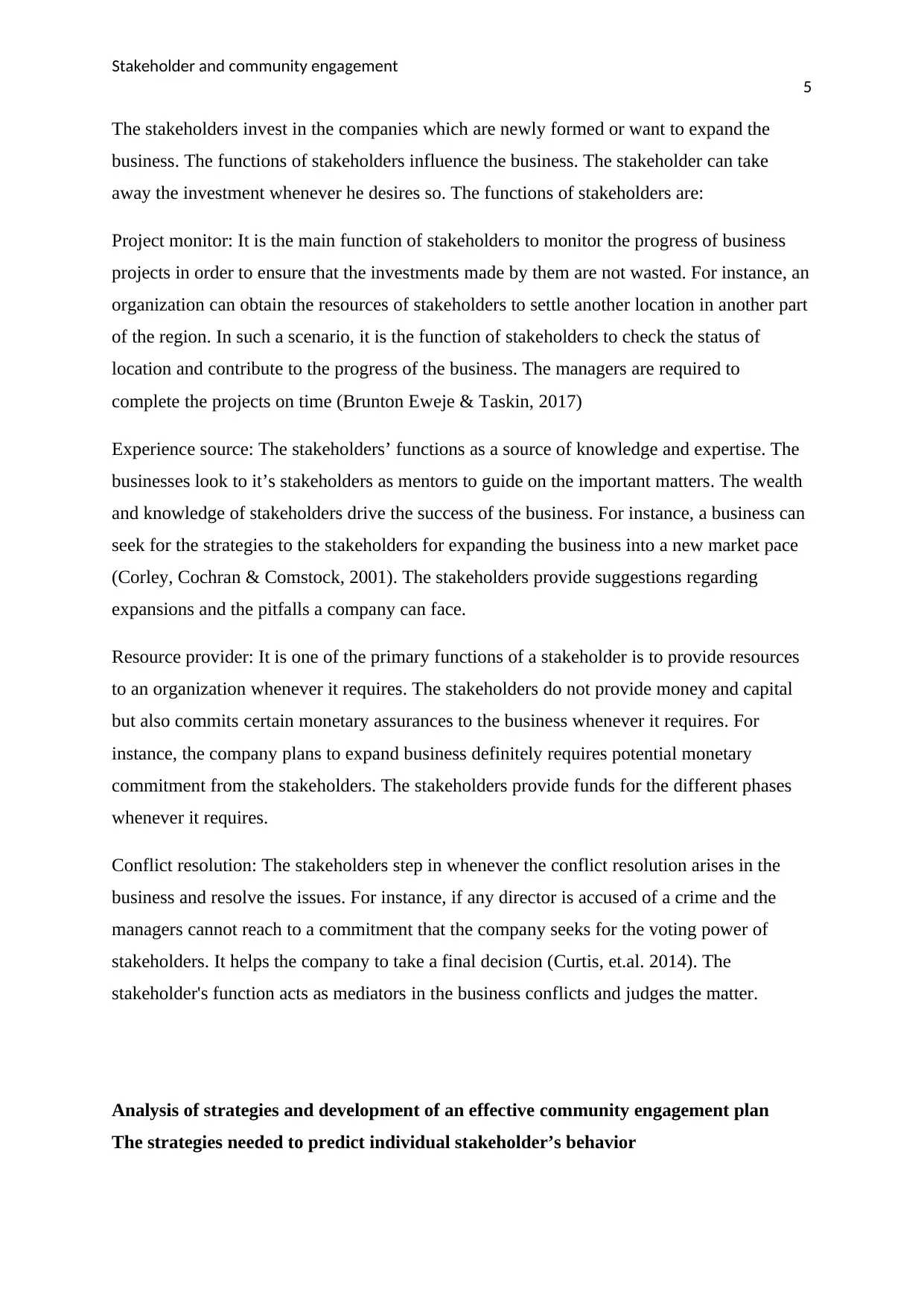
Stakeholder and community engagement
5
The stakeholders invest in the companies which are newly formed or want to expand the
business. The functions of stakeholders influence the business. The stakeholder can take
away the investment whenever he desires so. The functions of stakeholders are:
Project monitor: It is the main function of stakeholders to monitor the progress of business
projects in order to ensure that the investments made by them are not wasted. For instance, an
organization can obtain the resources of stakeholders to settle another location in another part
of the region. In such a scenario, it is the function of stakeholders to check the status of
location and contribute to the progress of the business. The managers are required to
complete the projects on time (Brunton Eweje & Taskin, 2017)
Experience source: The stakeholders’ functions as a source of knowledge and expertise. The
businesses look to it’s stakeholders as mentors to guide on the important matters. The wealth
and knowledge of stakeholders drive the success of the business. For instance, a business can
seek for the strategies to the stakeholders for expanding the business into a new market pace
(Corley, Cochran & Comstock, 2001). The stakeholders provide suggestions regarding
expansions and the pitfalls a company can face.
Resource provider: It is one of the primary functions of a stakeholder is to provide resources
to an organization whenever it requires. The stakeholders do not provide money and capital
but also commits certain monetary assurances to the business whenever it requires. For
instance, the company plans to expand business definitely requires potential monetary
commitment from the stakeholders. The stakeholders provide funds for the different phases
whenever it requires.
Conflict resolution: The stakeholders step in whenever the conflict resolution arises in the
business and resolve the issues. For instance, if any director is accused of a crime and the
managers cannot reach to a commitment that the company seeks for the voting power of
stakeholders. It helps the company to take a final decision (Curtis, et.al. 2014). The
stakeholder's function acts as mediators in the business conflicts and judges the matter.
Analysis of strategies and development of an effective community engagement plan
The strategies needed to predict individual stakeholder’s behavior
5
The stakeholders invest in the companies which are newly formed or want to expand the
business. The functions of stakeholders influence the business. The stakeholder can take
away the investment whenever he desires so. The functions of stakeholders are:
Project monitor: It is the main function of stakeholders to monitor the progress of business
projects in order to ensure that the investments made by them are not wasted. For instance, an
organization can obtain the resources of stakeholders to settle another location in another part
of the region. In such a scenario, it is the function of stakeholders to check the status of
location and contribute to the progress of the business. The managers are required to
complete the projects on time (Brunton Eweje & Taskin, 2017)
Experience source: The stakeholders’ functions as a source of knowledge and expertise. The
businesses look to it’s stakeholders as mentors to guide on the important matters. The wealth
and knowledge of stakeholders drive the success of the business. For instance, a business can
seek for the strategies to the stakeholders for expanding the business into a new market pace
(Corley, Cochran & Comstock, 2001). The stakeholders provide suggestions regarding
expansions and the pitfalls a company can face.
Resource provider: It is one of the primary functions of a stakeholder is to provide resources
to an organization whenever it requires. The stakeholders do not provide money and capital
but also commits certain monetary assurances to the business whenever it requires. For
instance, the company plans to expand business definitely requires potential monetary
commitment from the stakeholders. The stakeholders provide funds for the different phases
whenever it requires.
Conflict resolution: The stakeholders step in whenever the conflict resolution arises in the
business and resolve the issues. For instance, if any director is accused of a crime and the
managers cannot reach to a commitment that the company seeks for the voting power of
stakeholders. It helps the company to take a final decision (Curtis, et.al. 2014). The
stakeholder's function acts as mediators in the business conflicts and judges the matter.
Analysis of strategies and development of an effective community engagement plan
The strategies needed to predict individual stakeholder’s behavior
⊘ This is a preview!⊘
Do you want full access?
Subscribe today to unlock all pages.

Trusted by 1+ million students worldwide
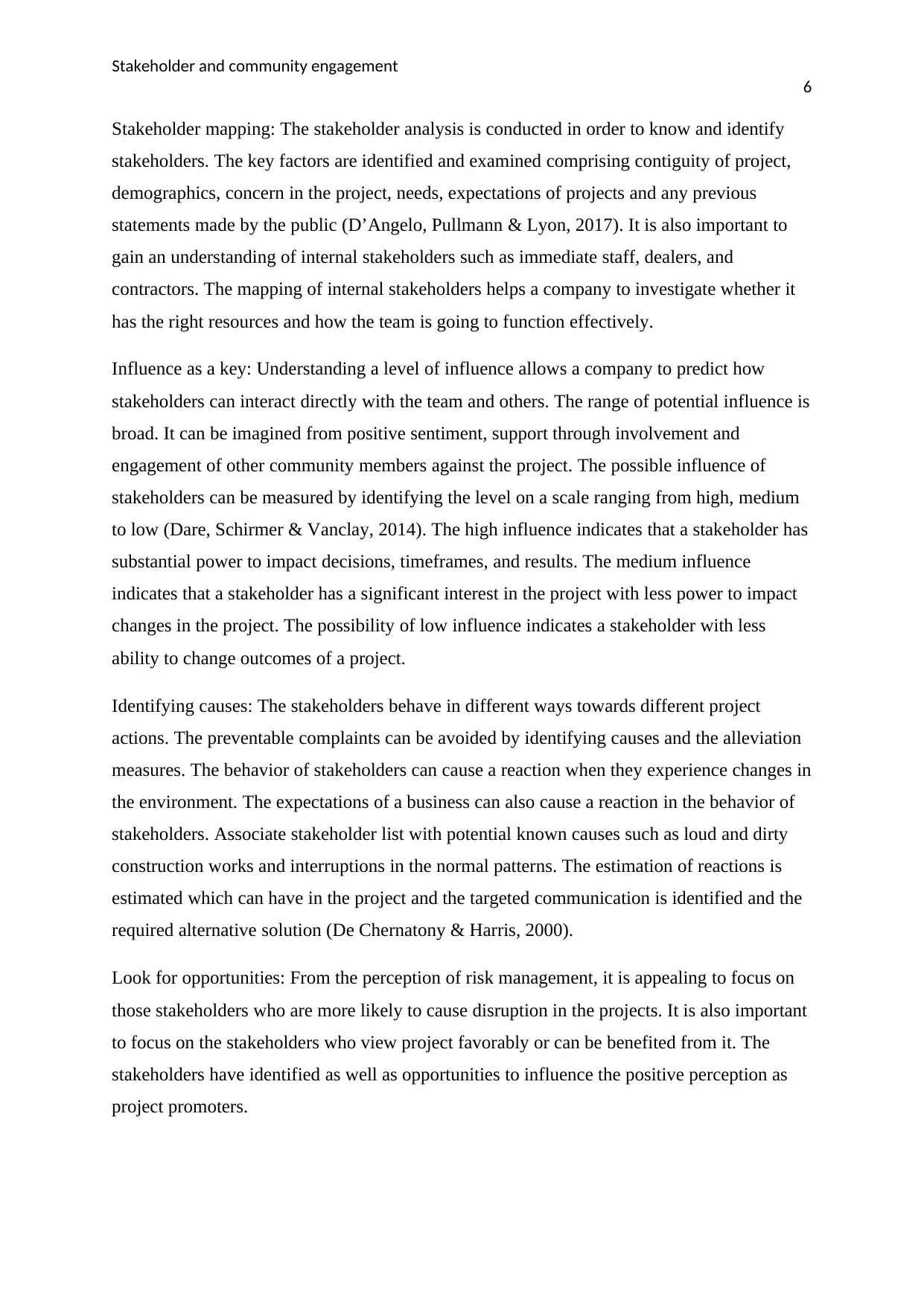
Stakeholder and community engagement
6
Stakeholder mapping: The stakeholder analysis is conducted in order to know and identify
stakeholders. The key factors are identified and examined comprising contiguity of project,
demographics, concern in the project, needs, expectations of projects and any previous
statements made by the public (D’Angelo, Pullmann & Lyon, 2017). It is also important to
gain an understanding of internal stakeholders such as immediate staff, dealers, and
contractors. The mapping of internal stakeholders helps a company to investigate whether it
has the right resources and how the team is going to function effectively.
Influence as a key: Understanding a level of influence allows a company to predict how
stakeholders can interact directly with the team and others. The range of potential influence is
broad. It can be imagined from positive sentiment, support through involvement and
engagement of other community members against the project. The possible influence of
stakeholders can be measured by identifying the level on a scale ranging from high, medium
to low (Dare, Schirmer & Vanclay, 2014). The high influence indicates that a stakeholder has
substantial power to impact decisions, timeframes, and results. The medium influence
indicates that a stakeholder has a significant interest in the project with less power to impact
changes in the project. The possibility of low influence indicates a stakeholder with less
ability to change outcomes of a project.
Identifying causes: The stakeholders behave in different ways towards different project
actions. The preventable complaints can be avoided by identifying causes and the alleviation
measures. The behavior of stakeholders can cause a reaction when they experience changes in
the environment. The expectations of a business can also cause a reaction in the behavior of
stakeholders. Associate stakeholder list with potential known causes such as loud and dirty
construction works and interruptions in the normal patterns. The estimation of reactions is
estimated which can have in the project and the targeted communication is identified and the
required alternative solution (De Chernatony & Harris, 2000).
Look for opportunities: From the perception of risk management, it is appealing to focus on
those stakeholders who are more likely to cause disruption in the projects. It is also important
to focus on the stakeholders who view project favorably or can be benefited from it. The
stakeholders have identified as well as opportunities to influence the positive perception as
project promoters.
6
Stakeholder mapping: The stakeholder analysis is conducted in order to know and identify
stakeholders. The key factors are identified and examined comprising contiguity of project,
demographics, concern in the project, needs, expectations of projects and any previous
statements made by the public (D’Angelo, Pullmann & Lyon, 2017). It is also important to
gain an understanding of internal stakeholders such as immediate staff, dealers, and
contractors. The mapping of internal stakeholders helps a company to investigate whether it
has the right resources and how the team is going to function effectively.
Influence as a key: Understanding a level of influence allows a company to predict how
stakeholders can interact directly with the team and others. The range of potential influence is
broad. It can be imagined from positive sentiment, support through involvement and
engagement of other community members against the project. The possible influence of
stakeholders can be measured by identifying the level on a scale ranging from high, medium
to low (Dare, Schirmer & Vanclay, 2014). The high influence indicates that a stakeholder has
substantial power to impact decisions, timeframes, and results. The medium influence
indicates that a stakeholder has a significant interest in the project with less power to impact
changes in the project. The possibility of low influence indicates a stakeholder with less
ability to change outcomes of a project.
Identifying causes: The stakeholders behave in different ways towards different project
actions. The preventable complaints can be avoided by identifying causes and the alleviation
measures. The behavior of stakeholders can cause a reaction when they experience changes in
the environment. The expectations of a business can also cause a reaction in the behavior of
stakeholders. Associate stakeholder list with potential known causes such as loud and dirty
construction works and interruptions in the normal patterns. The estimation of reactions is
estimated which can have in the project and the targeted communication is identified and the
required alternative solution (De Chernatony & Harris, 2000).
Look for opportunities: From the perception of risk management, it is appealing to focus on
those stakeholders who are more likely to cause disruption in the projects. It is also important
to focus on the stakeholders who view project favorably or can be benefited from it. The
stakeholders have identified as well as opportunities to influence the positive perception as
project promoters.
Paraphrase This Document
Need a fresh take? Get an instant paraphrase of this document with our AI Paraphraser
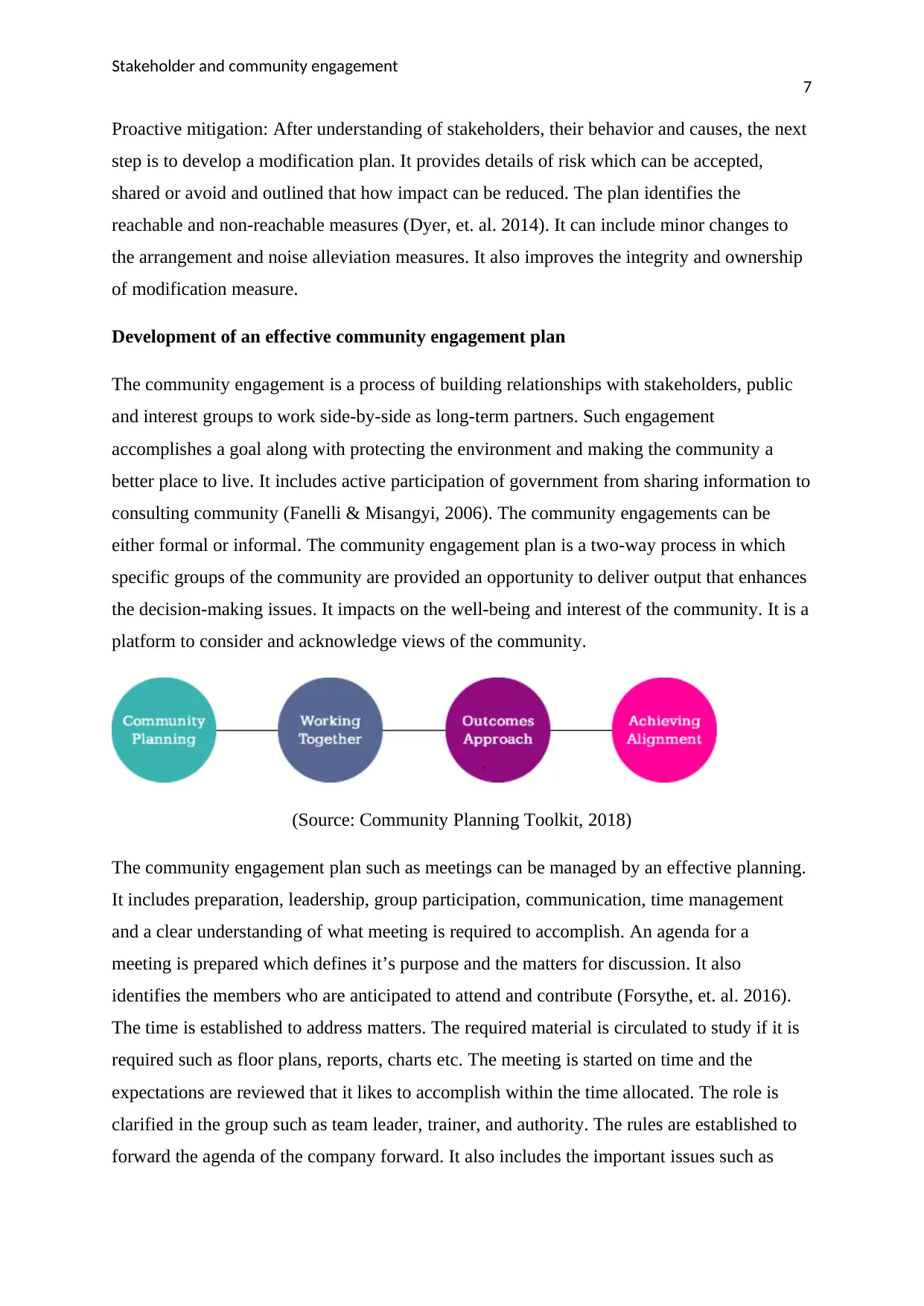
Stakeholder and community engagement
7
Proactive mitigation: After understanding of stakeholders, their behavior and causes, the next
step is to develop a modification plan. It provides details of risk which can be accepted,
shared or avoid and outlined that how impact can be reduced. The plan identifies the
reachable and non-reachable measures (Dyer, et. al. 2014). It can include minor changes to
the arrangement and noise alleviation measures. It also improves the integrity and ownership
of modification measure.
Development of an effective community engagement plan
The community engagement is a process of building relationships with stakeholders, public
and interest groups to work side-by-side as long-term partners. Such engagement
accomplishes a goal along with protecting the environment and making the community a
better place to live. It includes active participation of government from sharing information to
consulting community (Fanelli & Misangyi, 2006). The community engagements can be
either formal or informal. The community engagement plan is a two-way process in which
specific groups of the community are provided an opportunity to deliver output that enhances
the decision-making issues. It impacts on the well-being and interest of the community. It is a
platform to consider and acknowledge views of the community.
(Source: Community Planning Toolkit, 2018)
The community engagement plan such as meetings can be managed by an effective planning.
It includes preparation, leadership, group participation, communication, time management
and a clear understanding of what meeting is required to accomplish. An agenda for a
meeting is prepared which defines it’s purpose and the matters for discussion. It also
identifies the members who are anticipated to attend and contribute (Forsythe, et. al. 2016).
The time is established to address matters. The required material is circulated to study if it is
required such as floor plans, reports, charts etc. The meeting is started on time and the
expectations are reviewed that it likes to accomplish within the time allocated. The role is
clarified in the group such as team leader, trainer, and authority. The rules are established to
forward the agenda of the company forward. It also includes the important issues such as
7
Proactive mitigation: After understanding of stakeholders, their behavior and causes, the next
step is to develop a modification plan. It provides details of risk which can be accepted,
shared or avoid and outlined that how impact can be reduced. The plan identifies the
reachable and non-reachable measures (Dyer, et. al. 2014). It can include minor changes to
the arrangement and noise alleviation measures. It also improves the integrity and ownership
of modification measure.
Development of an effective community engagement plan
The community engagement is a process of building relationships with stakeholders, public
and interest groups to work side-by-side as long-term partners. Such engagement
accomplishes a goal along with protecting the environment and making the community a
better place to live. It includes active participation of government from sharing information to
consulting community (Fanelli & Misangyi, 2006). The community engagements can be
either formal or informal. The community engagement plan is a two-way process in which
specific groups of the community are provided an opportunity to deliver output that enhances
the decision-making issues. It impacts on the well-being and interest of the community. It is a
platform to consider and acknowledge views of the community.
(Source: Community Planning Toolkit, 2018)
The community engagement plan such as meetings can be managed by an effective planning.
It includes preparation, leadership, group participation, communication, time management
and a clear understanding of what meeting is required to accomplish. An agenda for a
meeting is prepared which defines it’s purpose and the matters for discussion. It also
identifies the members who are anticipated to attend and contribute (Forsythe, et. al. 2016).
The time is established to address matters. The required material is circulated to study if it is
required such as floor plans, reports, charts etc. The meeting is started on time and the
expectations are reviewed that it likes to accomplish within the time allocated. The role is
clarified in the group such as team leader, trainer, and authority. The rules are established to
forward the agenda of the company forward. It also includes the important issues such as
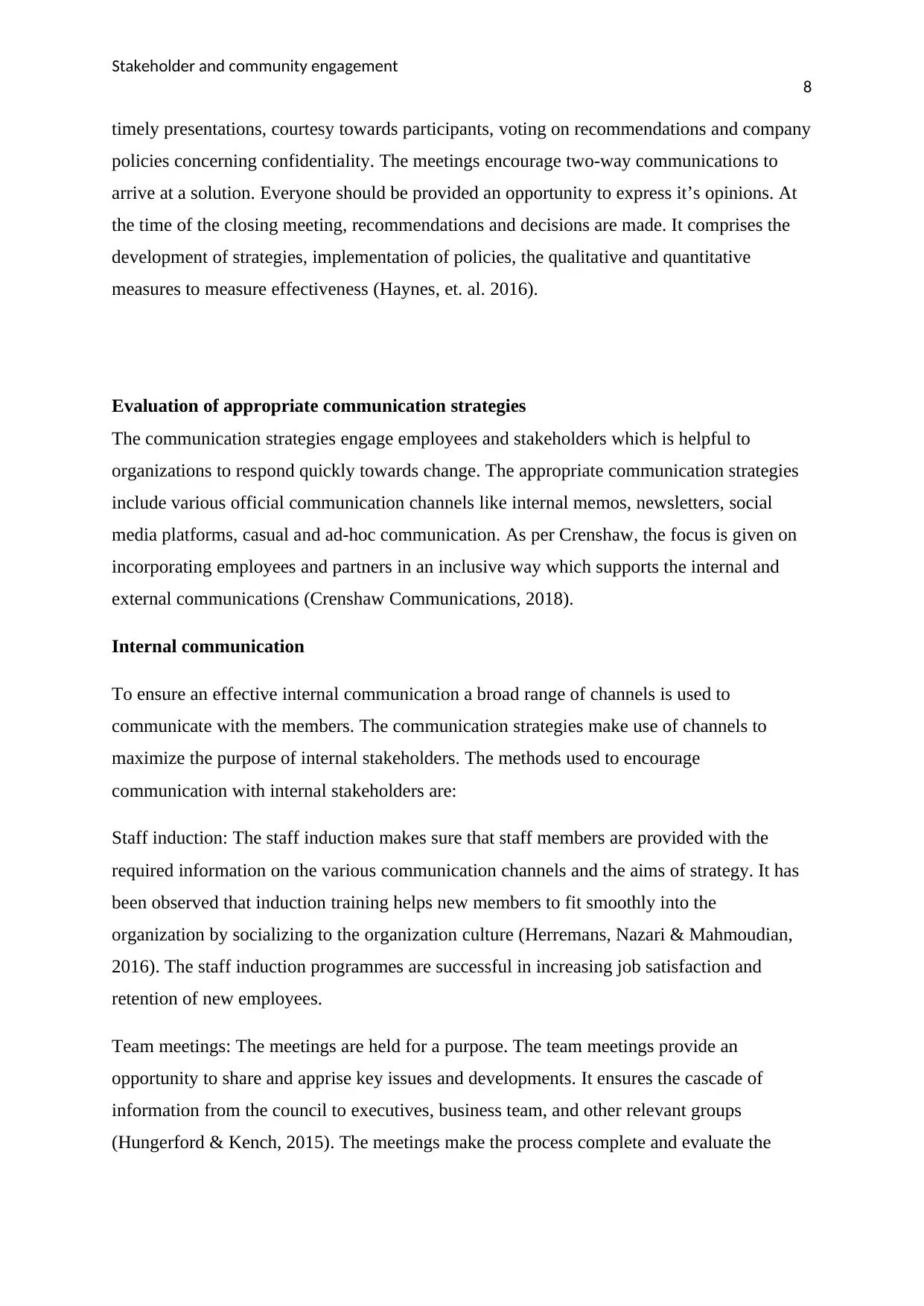
Stakeholder and community engagement
8
timely presentations, courtesy towards participants, voting on recommendations and company
policies concerning confidentiality. The meetings encourage two-way communications to
arrive at a solution. Everyone should be provided an opportunity to express it’s opinions. At
the time of the closing meeting, recommendations and decisions are made. It comprises the
development of strategies, implementation of policies, the qualitative and quantitative
measures to measure effectiveness (Haynes, et. al. 2016).
Evaluation of appropriate communication strategies
The communication strategies engage employees and stakeholders which is helpful to
organizations to respond quickly towards change. The appropriate communication strategies
include various official communication channels like internal memos, newsletters, social
media platforms, casual and ad-hoc communication. As per Crenshaw, the focus is given on
incorporating employees and partners in an inclusive way which supports the internal and
external communications (Crenshaw Communications, 2018).
Internal communication
To ensure an effective internal communication a broad range of channels is used to
communicate with the members. The communication strategies make use of channels to
maximize the purpose of internal stakeholders. The methods used to encourage
communication with internal stakeholders are:
Staff induction: The staff induction makes sure that staff members are provided with the
required information on the various communication channels and the aims of strategy. It has
been observed that induction training helps new members to fit smoothly into the
organization by socializing to the organization culture (Herremans, Nazari & Mahmoudian,
2016). The staff induction programmes are successful in increasing job satisfaction and
retention of new employees.
Team meetings: The meetings are held for a purpose. The team meetings provide an
opportunity to share and apprise key issues and developments. It ensures the cascade of
information from the council to executives, business team, and other relevant groups
(Hungerford & Kench, 2015). The meetings make the process complete and evaluate the
8
timely presentations, courtesy towards participants, voting on recommendations and company
policies concerning confidentiality. The meetings encourage two-way communications to
arrive at a solution. Everyone should be provided an opportunity to express it’s opinions. At
the time of the closing meeting, recommendations and decisions are made. It comprises the
development of strategies, implementation of policies, the qualitative and quantitative
measures to measure effectiveness (Haynes, et. al. 2016).
Evaluation of appropriate communication strategies
The communication strategies engage employees and stakeholders which is helpful to
organizations to respond quickly towards change. The appropriate communication strategies
include various official communication channels like internal memos, newsletters, social
media platforms, casual and ad-hoc communication. As per Crenshaw, the focus is given on
incorporating employees and partners in an inclusive way which supports the internal and
external communications (Crenshaw Communications, 2018).
Internal communication
To ensure an effective internal communication a broad range of channels is used to
communicate with the members. The communication strategies make use of channels to
maximize the purpose of internal stakeholders. The methods used to encourage
communication with internal stakeholders are:
Staff induction: The staff induction makes sure that staff members are provided with the
required information on the various communication channels and the aims of strategy. It has
been observed that induction training helps new members to fit smoothly into the
organization by socializing to the organization culture (Herremans, Nazari & Mahmoudian,
2016). The staff induction programmes are successful in increasing job satisfaction and
retention of new employees.
Team meetings: The meetings are held for a purpose. The team meetings provide an
opportunity to share and apprise key issues and developments. It ensures the cascade of
information from the council to executives, business team, and other relevant groups
(Hungerford & Kench, 2015). The meetings make the process complete and evaluate the
⊘ This is a preview!⊘
Do you want full access?
Subscribe today to unlock all pages.

Trusted by 1+ million students worldwide
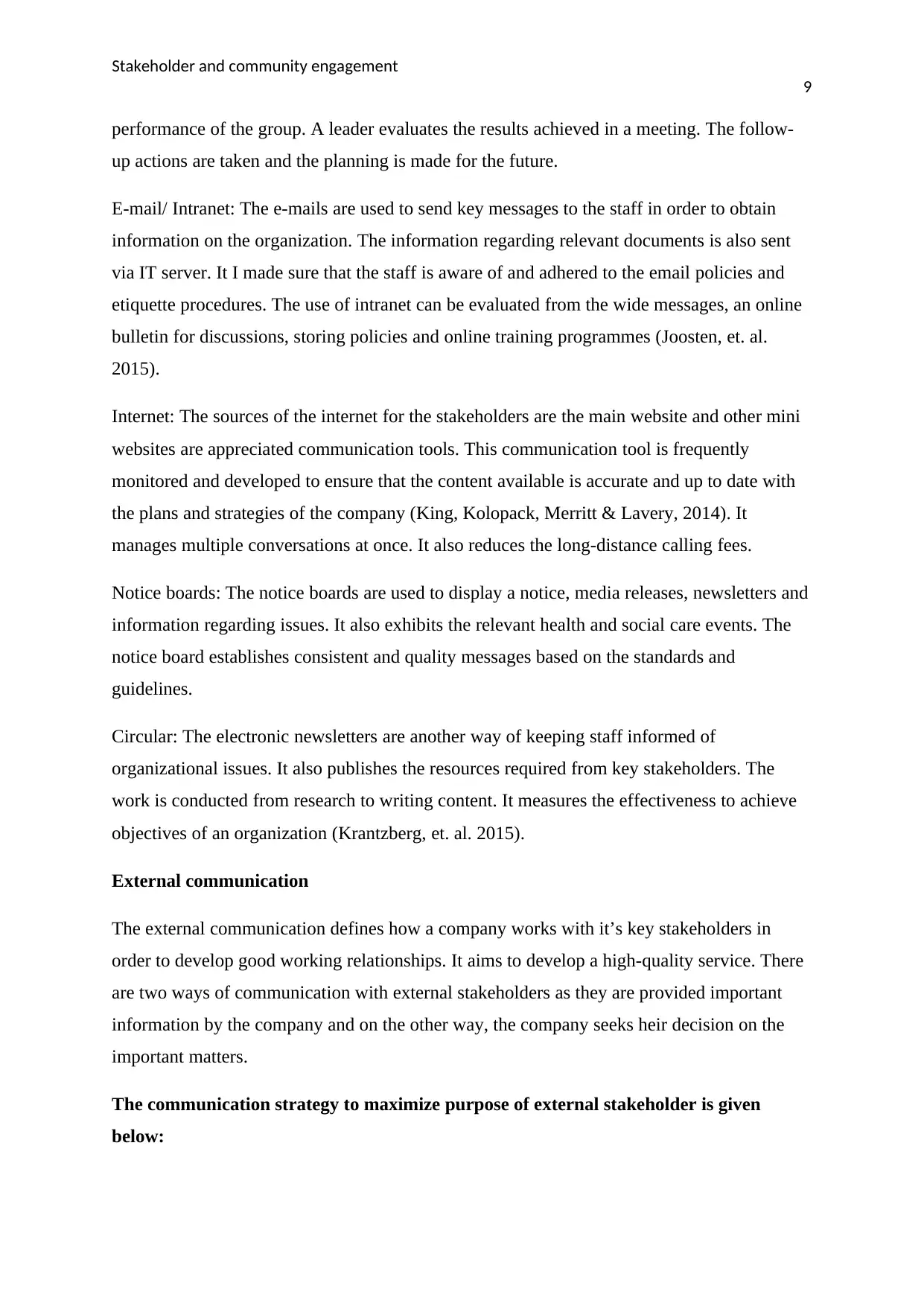
Stakeholder and community engagement
9
performance of the group. A leader evaluates the results achieved in a meeting. The follow-
up actions are taken and the planning is made for the future.
E-mail/ Intranet: The e-mails are used to send key messages to the staff in order to obtain
information on the organization. The information regarding relevant documents is also sent
via IT server. It I made sure that the staff is aware of and adhered to the email policies and
etiquette procedures. The use of intranet can be evaluated from the wide messages, an online
bulletin for discussions, storing policies and online training programmes (Joosten, et. al.
2015).
Internet: The sources of the internet for the stakeholders are the main website and other mini
websites are appreciated communication tools. This communication tool is frequently
monitored and developed to ensure that the content available is accurate and up to date with
the plans and strategies of the company (King, Kolopack, Merritt & Lavery, 2014). It
manages multiple conversations at once. It also reduces the long-distance calling fees.
Notice boards: The notice boards are used to display a notice, media releases, newsletters and
information regarding issues. It also exhibits the relevant health and social care events. The
notice board establishes consistent and quality messages based on the standards and
guidelines.
Circular: The electronic newsletters are another way of keeping staff informed of
organizational issues. It also publishes the resources required from key stakeholders. The
work is conducted from research to writing content. It measures the effectiveness to achieve
objectives of an organization (Krantzberg, et. al. 2015).
External communication
The external communication defines how a company works with it’s key stakeholders in
order to develop good working relationships. It aims to develop a high-quality service. There
are two ways of communication with external stakeholders as they are provided important
information by the company and on the other way, the company seeks heir decision on the
important matters.
The communication strategy to maximize purpose of external stakeholder is given
below:
9
performance of the group. A leader evaluates the results achieved in a meeting. The follow-
up actions are taken and the planning is made for the future.
E-mail/ Intranet: The e-mails are used to send key messages to the staff in order to obtain
information on the organization. The information regarding relevant documents is also sent
via IT server. It I made sure that the staff is aware of and adhered to the email policies and
etiquette procedures. The use of intranet can be evaluated from the wide messages, an online
bulletin for discussions, storing policies and online training programmes (Joosten, et. al.
2015).
Internet: The sources of the internet for the stakeholders are the main website and other mini
websites are appreciated communication tools. This communication tool is frequently
monitored and developed to ensure that the content available is accurate and up to date with
the plans and strategies of the company (King, Kolopack, Merritt & Lavery, 2014). It
manages multiple conversations at once. It also reduces the long-distance calling fees.
Notice boards: The notice boards are used to display a notice, media releases, newsletters and
information regarding issues. It also exhibits the relevant health and social care events. The
notice board establishes consistent and quality messages based on the standards and
guidelines.
Circular: The electronic newsletters are another way of keeping staff informed of
organizational issues. It also publishes the resources required from key stakeholders. The
work is conducted from research to writing content. It measures the effectiveness to achieve
objectives of an organization (Krantzberg, et. al. 2015).
External communication
The external communication defines how a company works with it’s key stakeholders in
order to develop good working relationships. It aims to develop a high-quality service. There
are two ways of communication with external stakeholders as they are provided important
information by the company and on the other way, the company seeks heir decision on the
important matters.
The communication strategy to maximize purpose of external stakeholder is given
below:
Paraphrase This Document
Need a fresh take? Get an instant paraphrase of this document with our AI Paraphraser
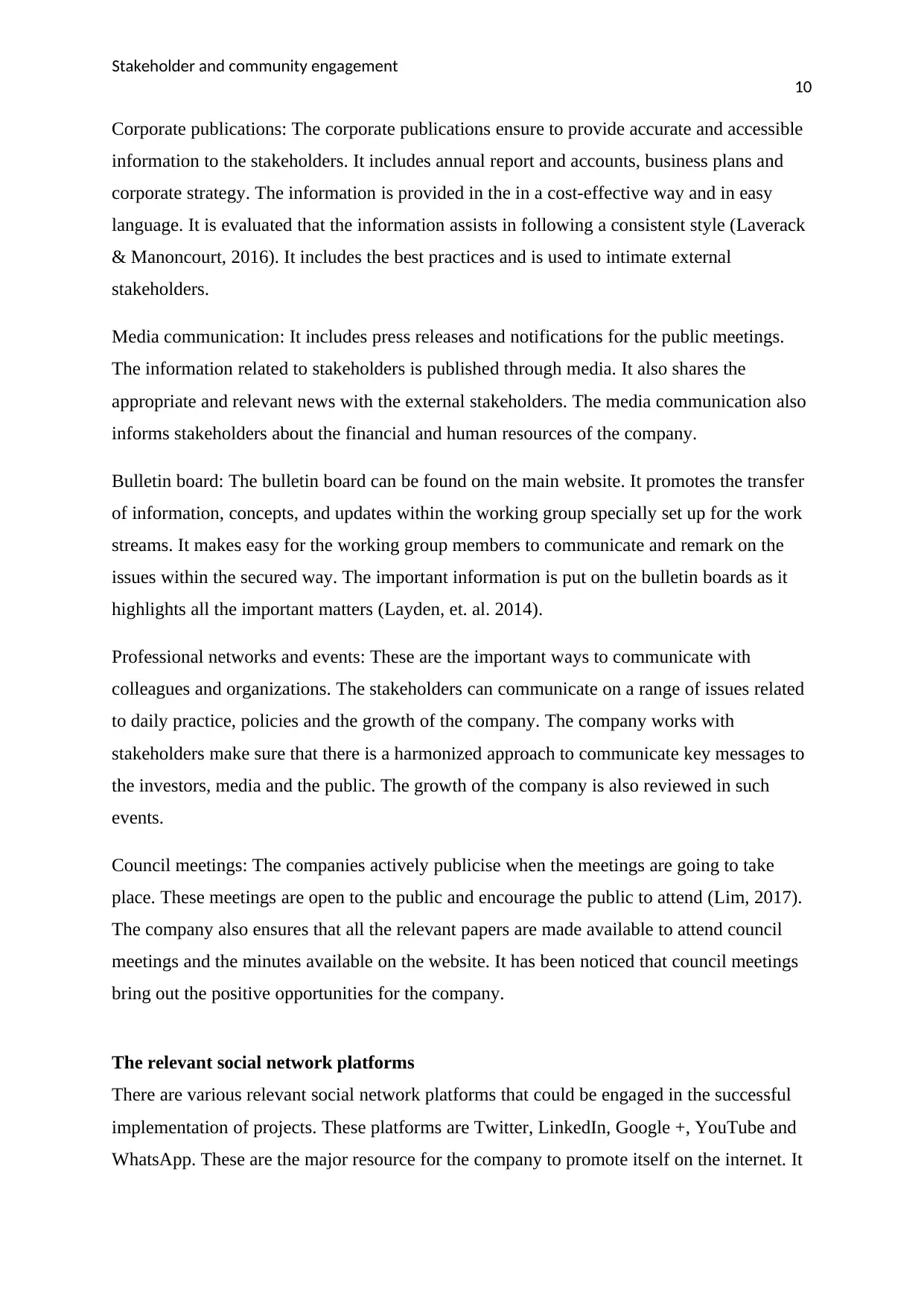
Stakeholder and community engagement
10
Corporate publications: The corporate publications ensure to provide accurate and accessible
information to the stakeholders. It includes annual report and accounts, business plans and
corporate strategy. The information is provided in the in a cost-effective way and in easy
language. It is evaluated that the information assists in following a consistent style (Laverack
& Manoncourt, 2016). It includes the best practices and is used to intimate external
stakeholders.
Media communication: It includes press releases and notifications for the public meetings.
The information related to stakeholders is published through media. It also shares the
appropriate and relevant news with the external stakeholders. The media communication also
informs stakeholders about the financial and human resources of the company.
Bulletin board: The bulletin board can be found on the main website. It promotes the transfer
of information, concepts, and updates within the working group specially set up for the work
streams. It makes easy for the working group members to communicate and remark on the
issues within the secured way. The important information is put on the bulletin boards as it
highlights all the important matters (Layden, et. al. 2014).
Professional networks and events: These are the important ways to communicate with
colleagues and organizations. The stakeholders can communicate on a range of issues related
to daily practice, policies and the growth of the company. The company works with
stakeholders make sure that there is a harmonized approach to communicate key messages to
the investors, media and the public. The growth of the company is also reviewed in such
events.
Council meetings: The companies actively publicise when the meetings are going to take
place. These meetings are open to the public and encourage the public to attend (Lim, 2017).
The company also ensures that all the relevant papers are made available to attend council
meetings and the minutes available on the website. It has been noticed that council meetings
bring out the positive opportunities for the company.
The relevant social network platforms
There are various relevant social network platforms that could be engaged in the successful
implementation of projects. These platforms are Twitter, LinkedIn, Google +, YouTube and
WhatsApp. These are the major resource for the company to promote itself on the internet. It
10
Corporate publications: The corporate publications ensure to provide accurate and accessible
information to the stakeholders. It includes annual report and accounts, business plans and
corporate strategy. The information is provided in the in a cost-effective way and in easy
language. It is evaluated that the information assists in following a consistent style (Laverack
& Manoncourt, 2016). It includes the best practices and is used to intimate external
stakeholders.
Media communication: It includes press releases and notifications for the public meetings.
The information related to stakeholders is published through media. It also shares the
appropriate and relevant news with the external stakeholders. The media communication also
informs stakeholders about the financial and human resources of the company.
Bulletin board: The bulletin board can be found on the main website. It promotes the transfer
of information, concepts, and updates within the working group specially set up for the work
streams. It makes easy for the working group members to communicate and remark on the
issues within the secured way. The important information is put on the bulletin boards as it
highlights all the important matters (Layden, et. al. 2014).
Professional networks and events: These are the important ways to communicate with
colleagues and organizations. The stakeholders can communicate on a range of issues related
to daily practice, policies and the growth of the company. The company works with
stakeholders make sure that there is a harmonized approach to communicate key messages to
the investors, media and the public. The growth of the company is also reviewed in such
events.
Council meetings: The companies actively publicise when the meetings are going to take
place. These meetings are open to the public and encourage the public to attend (Lim, 2017).
The company also ensures that all the relevant papers are made available to attend council
meetings and the minutes available on the website. It has been noticed that council meetings
bring out the positive opportunities for the company.
The relevant social network platforms
There are various relevant social network platforms that could be engaged in the successful
implementation of projects. These platforms are Twitter, LinkedIn, Google +, YouTube and
WhatsApp. These are the major resource for the company to promote itself on the internet. It
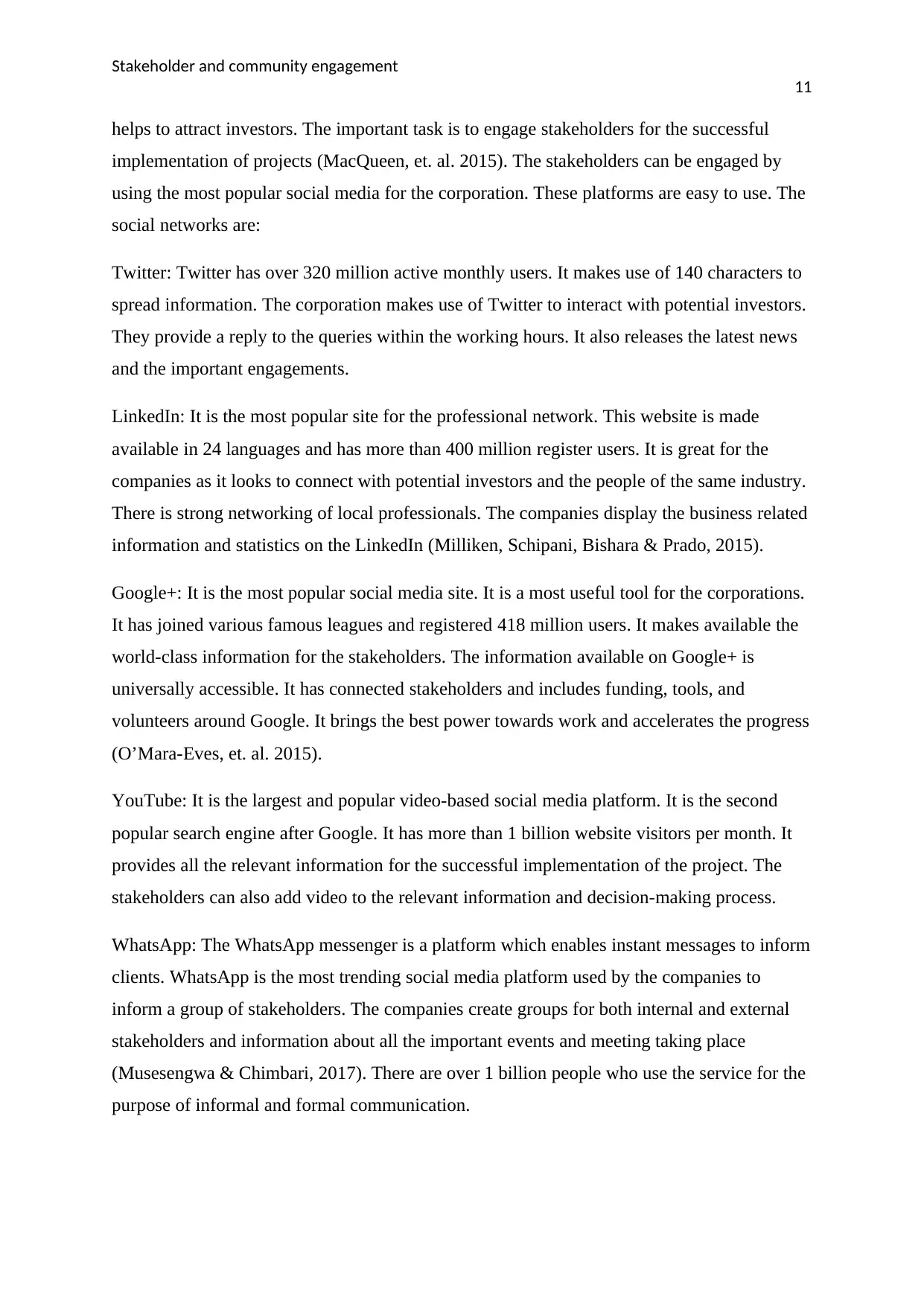
Stakeholder and community engagement
11
helps to attract investors. The important task is to engage stakeholders for the successful
implementation of projects (MacQueen, et. al. 2015). The stakeholders can be engaged by
using the most popular social media for the corporation. These platforms are easy to use. The
social networks are:
Twitter: Twitter has over 320 million active monthly users. It makes use of 140 characters to
spread information. The corporation makes use of Twitter to interact with potential investors.
They provide a reply to the queries within the working hours. It also releases the latest news
and the important engagements.
LinkedIn: It is the most popular site for the professional network. This website is made
available in 24 languages and has more than 400 million register users. It is great for the
companies as it looks to connect with potential investors and the people of the same industry.
There is strong networking of local professionals. The companies display the business related
information and statistics on the LinkedIn (Milliken, Schipani, Bishara & Prado, 2015).
Google+: It is the most popular social media site. It is a most useful tool for the corporations.
It has joined various famous leagues and registered 418 million users. It makes available the
world-class information for the stakeholders. The information available on Google+ is
universally accessible. It has connected stakeholders and includes funding, tools, and
volunteers around Google. It brings the best power towards work and accelerates the progress
(O’Mara-Eves, et. al. 2015).
YouTube: It is the largest and popular video-based social media platform. It is the second
popular search engine after Google. It has more than 1 billion website visitors per month. It
provides all the relevant information for the successful implementation of the project. The
stakeholders can also add video to the relevant information and decision-making process.
WhatsApp: The WhatsApp messenger is a platform which enables instant messages to inform
clients. WhatsApp is the most trending social media platform used by the companies to
inform a group of stakeholders. The companies create groups for both internal and external
stakeholders and information about all the important events and meeting taking place
(Musesengwa & Chimbari, 2017). There are over 1 billion people who use the service for the
purpose of informal and formal communication.
11
helps to attract investors. The important task is to engage stakeholders for the successful
implementation of projects (MacQueen, et. al. 2015). The stakeholders can be engaged by
using the most popular social media for the corporation. These platforms are easy to use. The
social networks are:
Twitter: Twitter has over 320 million active monthly users. It makes use of 140 characters to
spread information. The corporation makes use of Twitter to interact with potential investors.
They provide a reply to the queries within the working hours. It also releases the latest news
and the important engagements.
LinkedIn: It is the most popular site for the professional network. This website is made
available in 24 languages and has more than 400 million register users. It is great for the
companies as it looks to connect with potential investors and the people of the same industry.
There is strong networking of local professionals. The companies display the business related
information and statistics on the LinkedIn (Milliken, Schipani, Bishara & Prado, 2015).
Google+: It is the most popular social media site. It is a most useful tool for the corporations.
It has joined various famous leagues and registered 418 million users. It makes available the
world-class information for the stakeholders. The information available on Google+ is
universally accessible. It has connected stakeholders and includes funding, tools, and
volunteers around Google. It brings the best power towards work and accelerates the progress
(O’Mara-Eves, et. al. 2015).
YouTube: It is the largest and popular video-based social media platform. It is the second
popular search engine after Google. It has more than 1 billion website visitors per month. It
provides all the relevant information for the successful implementation of the project. The
stakeholders can also add video to the relevant information and decision-making process.
WhatsApp: The WhatsApp messenger is a platform which enables instant messages to inform
clients. WhatsApp is the most trending social media platform used by the companies to
inform a group of stakeholders. The companies create groups for both internal and external
stakeholders and information about all the important events and meeting taking place
(Musesengwa & Chimbari, 2017). There are over 1 billion people who use the service for the
purpose of informal and formal communication.
⊘ This is a preview!⊘
Do you want full access?
Subscribe today to unlock all pages.

Trusted by 1+ million students worldwide
1 out of 18
Related Documents
Your All-in-One AI-Powered Toolkit for Academic Success.
+13062052269
info@desklib.com
Available 24*7 on WhatsApp / Email
![[object Object]](/_next/static/media/star-bottom.7253800d.svg)
Unlock your academic potential
Copyright © 2020–2025 A2Z Services. All Rights Reserved. Developed and managed by ZUCOL.





